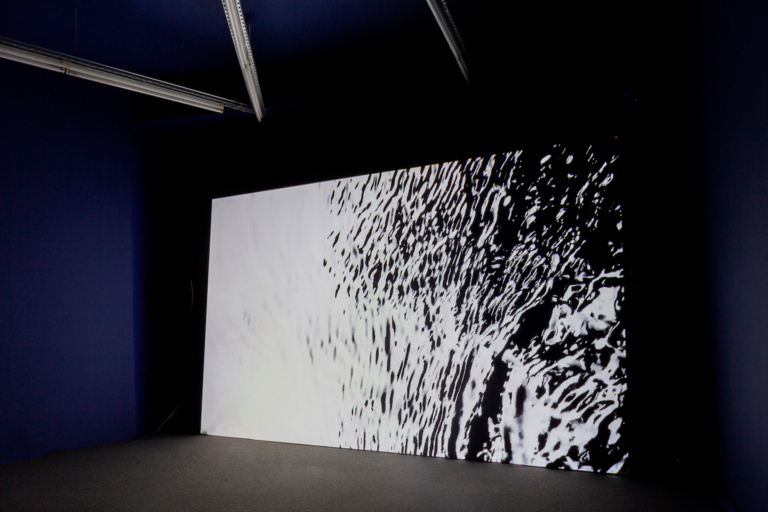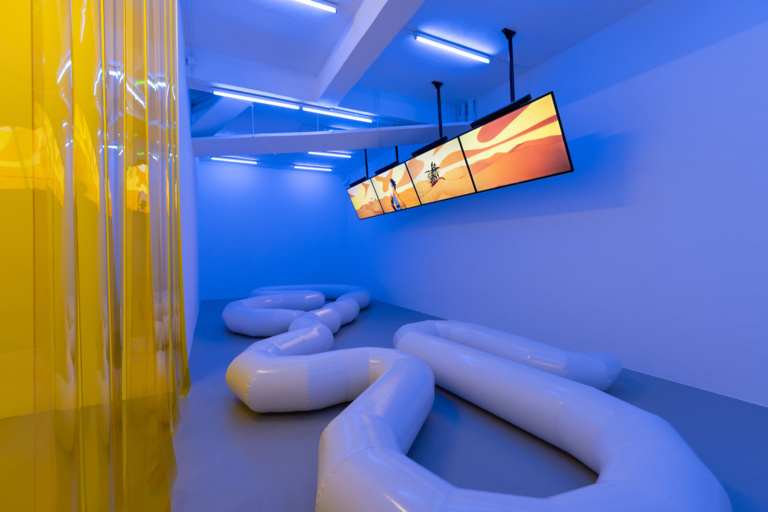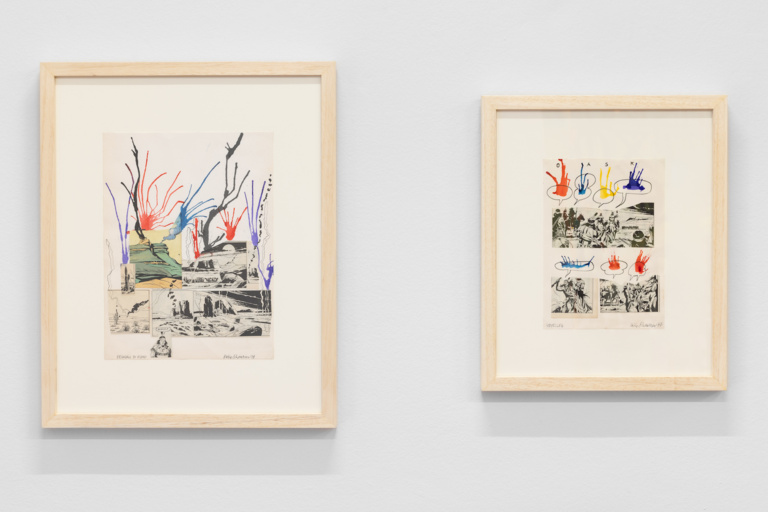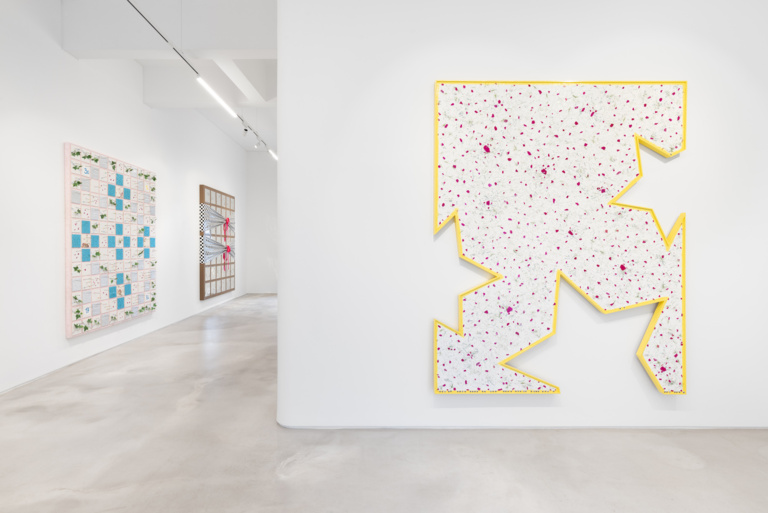Review — by Estelle Nabeyrat
Having just inaugurated a new project at the Kunst-Werke Berlin (Identical, 10 June to 20 August), the work of British artist and filmmaker Emily Wardill is being presented all summer in Hourless and at large, an exhibition at the crossroads of the experimental and retrospective formats which acts as a clarification with regard to a complex and polymorphic body of work. Wardill has made a name for herself through her project installations and films, three of which are currently being shown at Casa São Roque: Game Keepers Without Game (2009), which won the Jarman Award in 2010, I Gave My Love a Cherry that Had No Stone (2016), and Night for Day (2020). Like many of her latest works, her films draw aesthetic inspiration from "expanded cinema"—a term that was coined in the mid 1960s to describe films that pushed the boundaries of cinema and the conventions of spectatorship—while engaging with imaginary layers of meaning.
Review — by Bernardo José de Souza
A snowstorm had blanketed the city just the day before my arrival in Helsinki. From the airport, I hopped on a train to KIASMA, where Daniel Steegmann Mangrané was putting the finishing touches on his solo show: A leaf shapes the eye. A sort of retrospective exhibition, it spans at least 25 years, for most of which the Spanish-born artist was in Brazil, where he crafted a body of work distinctly inspired in and derived from the abundant tropical nature found not only in Rio de Janeiro, his adopted city, but in the Atlantic Forest as a whole, as well as the Amazon and beyond.
Review — by Ana Salazar Herrera
The House of World Cultures (HKW) in Berlin, built in 1957 as a congress hall gifted by the United States and repurposed into an arts venue in 1987, was closed for several months of renovations, having recently reopened with a big bang under the new Artistic Directorship of Cameroonian curator Prof Dr Bonaventure Soh Bejeng Ndikung. A new collective universe has thus begun to expand within and outside the walls of this prestigious and unique institution. Every single brick seems to have been resignified in order not only to rethink and problematise, but also build and practice the concepts of House, the ideas of World, and the complexities of Cultures. Before delving into the profoundly moving inaugural exhibition, for which the entire curatorial team has worked on collectively for over a year, let us first study the strong acts that will remain beyond the end of the exhibition. Together, they articulate the incoming team’s deliberations and proposals about the role an art institution of our times must play.
Review — by Maria Kruglyak
Continuing the Drexciyan myth, initially created in 1990s Detroit by the homonymous Afrofuturist techno duo James Stinson and Gerald Donald, The Otolith Group (Anjalika Sagar and Kodwo Eshun) welcomes us into the subaquatic speculative space of A Sphere of Water Orbiting a Star at HANGAR — Centro de Investigação Artística. Curated by Margarida Mendes, the exhibition connects the Drexciyan countercultural legend to the historical and present reality of the transatlantic slave economy, where insurance deals allowed enslavers to be compensated for murder. A critical investigation including a semi-fictional archival space, a multi-channel installation, and a weekly screening of Hydra Decapita (2010), A Sphere of Water Orbiting a Star attempts to further this mythology by bringing a speculative Afrofuturism into current postcolonial, decolonial, and abolitionist realities.
Review — by Maria Kruglyak
Sara Sadik’s Dors petit dors at Kunsthalle Lissabon is a hypnotic, empowering meditation on overcoming a difficult childhood. The multimedia installation is something of a performance taking place partly in the virtual world through a video installation of a game walk-through, where the audience are passive observers, and partly in the dream-like physical space of the gallery in yellow and blue. Taking its name from the homonymous song by the French rapper JuL, a lullaby for the children whose realities don’t fit the “happy family” image, the exhibition set up mirrors the semi-awake state of listening to a lullaby by placing the viewer between the physical and the virtual reality.
Review — by Maria Kruglyak
CAConrad’s exhibition Hidden in the cave we forge of one another, curated by/with Pântano Books (Alice dos Reis and Isadora Pedro Neves Marques) for Batalha Centro de Cinema, was a magical web spun from poetry, film, publication, exhibition and performance. Sensitive and generous, it served as something of an introduction of the legendary poet CAConrad and their poetic and ritualistic work to the Portuguese audience and art scene—and opened a new pathway for the creation of a genuine community. Fittingly, Reis and Neves Marques are established young Portuguese artists in their own right working in visual, text and film art. Together, they run the publishing project Pântano Books, dedicated to translating English poetry into Portuguese and publishing new works in Portuguese. Their second publication was the first Portuguese translation of CAConrad of The Book of Frank (orig. 2010; trans. 2021)—leading to an invitation from Cinema Batalha to make a film, an interview, another publication and an installation.
Review — by Enzo Di Marino
La Révolution R.S.V.P. is the first solo exhibition by the Italian artist Pablo Echaurren (Rome, 1951) in Portugal. Supported by the Italian Council, a programme aimed to promote Italian art abroad, the exhibition is an attempt to represent the complex, heterogeneous practice of an extremely atypical artist. Through a vast apparatus of works, some of which are shown for the first time, consisting of drawings, paintings, fabrics, newspapers, magazines, and various archival materials, Pablo Echaurren's exhibition is a story of the Italian cultural ferment of the 1970s that tried to propose, not only with force, a different culture.
Review — by Cristina Sanchez-Kozyreva
Moving from its eponymous neighbourhood to the more upscale area of Estrela, Madragoa Gallery has found a new space adorned with high ceilings and stone arched-windows for an updated all-grown-up look. Despite this transition, the gallery remains committed to showcasing artistic practices with a side of the mischievous, and in particular the work of young artists. In line with this last point, their inaugural exhibition features New Works 2023, a series of sculptural paintings by Sarah Benslimane, a French-Algerian-Swiss artist based in Geneva and born in 1997, whose art pays homage to—yet departs from—the conventions of geometrical abstraction through several large three-dimensional pop-coloured canvases.
Review — by Maria Kruglyak
When speaking about ecology and environmental action, the conversation often circles back to an existential fear of survival of the human species. Driven by our ongoing exploitation of the Earth, this fear leads as much to avoidance of these questions as to environmental protest, resulting in a standstill that continues the current trajectory of environmental crisis. It was therefore a great joy to see that both the artists exhibited at Mater and those participating in Pela Terra: Gathering of Art and Ecology took a completely different approach: an environmentalism based on communality, attention, care and, ultimately, love.
Review — by Enzo Di Marino
"Pheromones and Gentlemen" is absolutely an exhibition—the second by Anna Hulačová at Galeria Pedro Cera in Lisbon—that at first glance appears to be a "statuary" exhibition, although we quickly realise that there is a small short-circuit between the classic subject-object opposition. Upon entering the gallery, our attention is immediately drawn to this group of men sculpted in raw concrete. These gentlemen, evoked from a not-so-recent past, seem engaged in ordinary conversation, smoking and paying no attention to their surroundings. (Not even to the fact that one of them is leaning against a giant iron! But we'll come back to this later.) Perhaps the first characteristic that becomes evident is the powerful materiality of the works—all the details sculpted in raw concrete radiate with a blinding anonymous grey. It's impossible not to be struck by how the artist manipulates the material through a skilful play of volumes and textures, giving ordinary concrete a plasticity usually attributed to much nobler materials.
Essay — by Luísa Santos
A história do texto que inicia a rubrica "Institution(ing)s", e da investigação com o mesmo título, começou num encontro com os desafios atuais dos museus de arte contemporânea no Tate Intensive: Making Tomorrow’s Art Museum, um programa de uma semana na Tate Modern, em Londres, em 2016, que juntou cerca de 30 profissionais das artes visuais do Brasil, China, Coreia do Sul, Rússia, Grécia, Portugal, Austrália, Nova Zelândia, Canadá, EUA, India, e Reino Unido. Encontrámo-nos na recém-inaugurada extensão do edifício, cuja construção e manutenção teve e tem um impacto tremendo no meio ambiente, impacto esse que é sentido de modos diferentes nas diferentes partes do mundo que a instituição diz querer representar.











